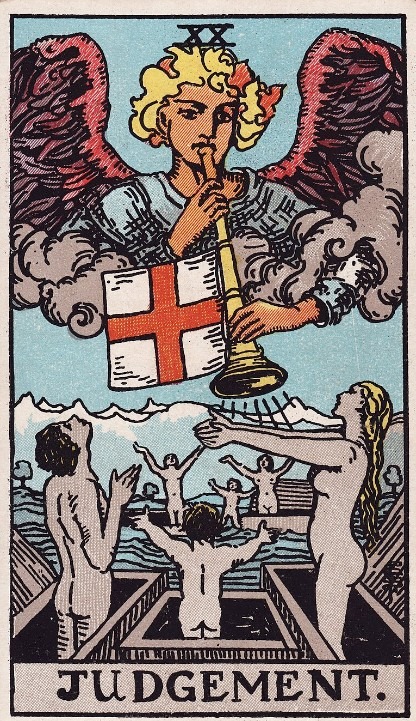
After the light and warmth of the sun, card 20 comes as a surprise – and a bit of a shock! It reminds him of sermons where the preacher spoke with enthusiasm about judgement day, the final judgement of god in a world corrupted by sin.
The fool thinks of coffins, cemeteries and the book of revelation, the only part of the bible which interested him. A red dragon with seven crowned heads, alongside monsters of sea and earth, had appealed to his young imagination, as did the horsemen of the apocalypse.
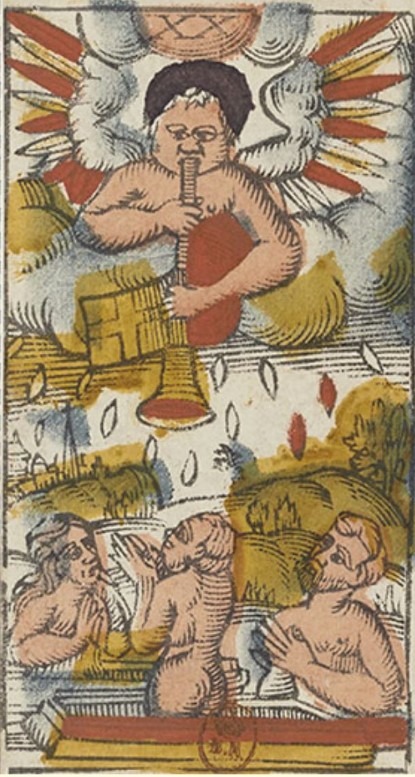
There are no monsters in card 20, but the dead are rising, seemingly resurrected by an angel’s trumpet call. The fool met angels in the lovers and temperance cards and here is a third one.
For the first time, the fool thinks about re-reading the bible. Maybe it’s more metaphorical than he’d previously considered. Perhaps it could be read from different perspectives. If references to jesus or god were substituted with light or energy, it would resemble teachings from esoteric groups like the Gnostics, Rosicrucians or Golden Dawn.
The fool’s walk through the tarot has taught him a new language. He’s learned to look at symbols and consider multiple layers of meaning.
Perhaps every religious path represents different answers to the same questions.
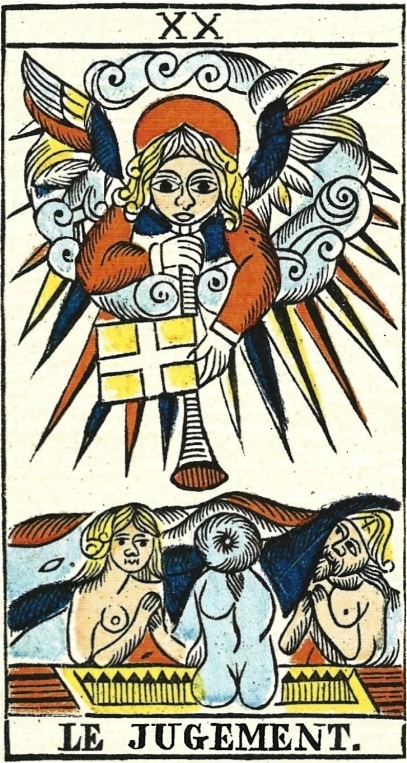
The idea shocks him with its simplicity. He knows it wouldn’t have occurred to him before he started this journey and his mother would be horrified!
He takes a deep breath.
Makes himself comfortable.
Waits to see what he can learn from this unexpected image on the penultimate card.
Early tarot decks called this card angel. It didn’t become judgement until the tarot travelled from Italy to France in the 1700’s.
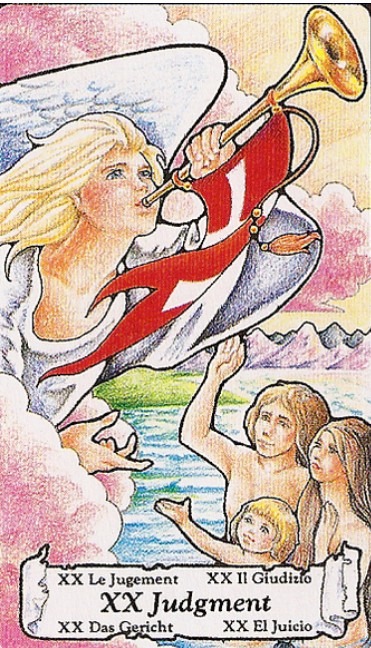
The first cards were similar to the Waite/Coleman Smith judgement in the early 20th century.
The 15th century Visconti Sforza tarot has two wingless angels are resurrecting a man and two women sharing the same tomb.
This card is unique in that it includes a figure of god watching over the events.

The Charles VI tarot, also known as the Gringonneur deck, had seven people rising from the dead while two winged angels reach down from the heavens with their trumpets.
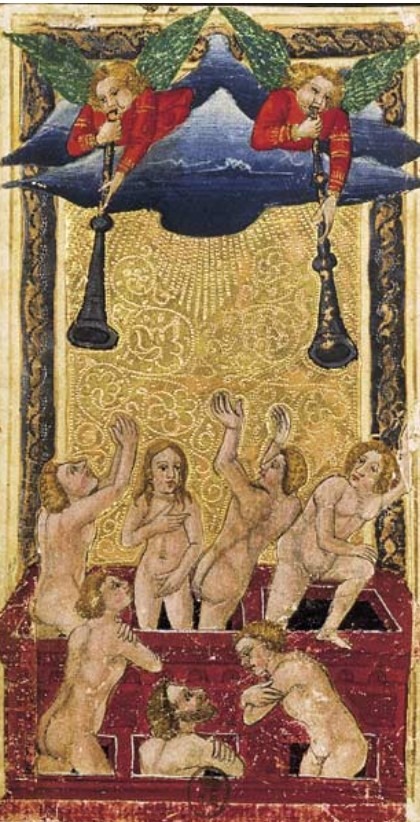
Another deck commissioned by the Visconti family is known as the Visconti di Modrone or Cary Yale Visconti tarot.
This card shows two angels with differently coloured wings.
A man and three women are emerging from elaborate pink stoned graves.
The image remained constant, suggesting that unlike some of the other cards in major arcana, judgement shares the same biblical source.
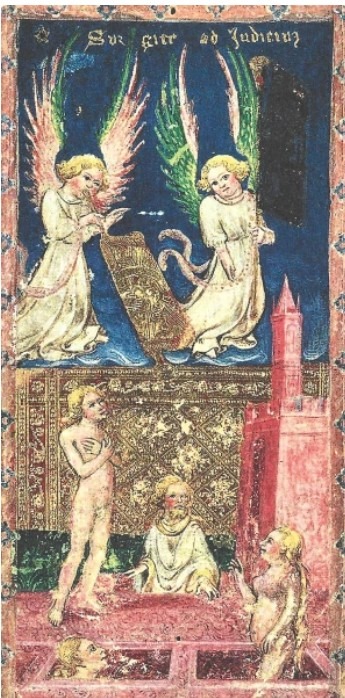
The Budapest, Rothschild and Rosenwald tarots from the 15th century all show resurrection scenes, dominated by a large angel.
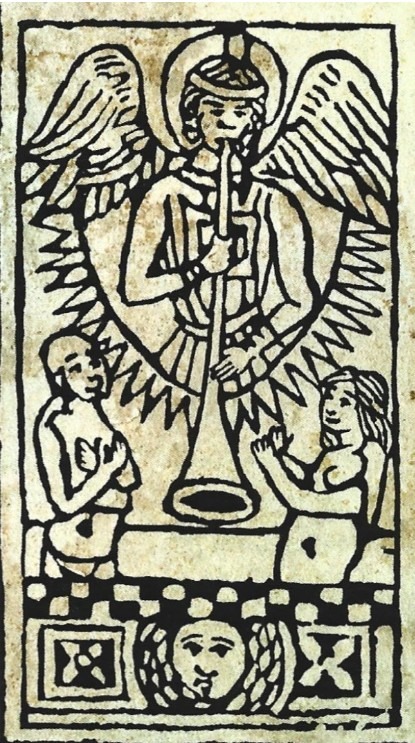
As the tarot travelled to France in the 17th century, the cards remain much the same, as in the Tarot de Paris and the Jacques Vievil tarots, where three people are rising in response to the trumpet call.
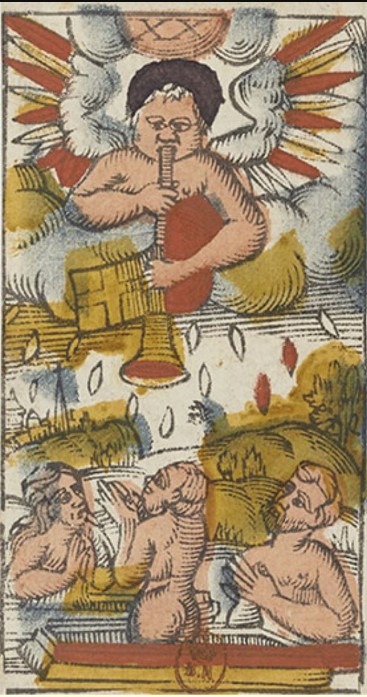
The French Marseilles tarot decks introduced a change of theme. The resurrected contain a tonsured monk as in the Jean Payen (1743) tarot while the Francois Gassmann tarot (1840) includes a crowned king.
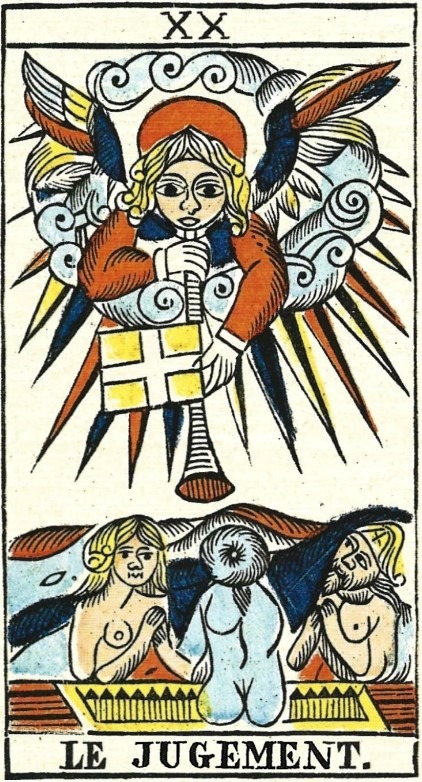
Decks influenced by the French occultists, such as the Oswald Wirth tarot.
The Wirth pack shows a man, woman and child.
Wirth named these as a mother, father and son and says the angel as Raphael who bears the mark of the sun on his forehead (Tarot of the Magicians, p116) as did temperance.
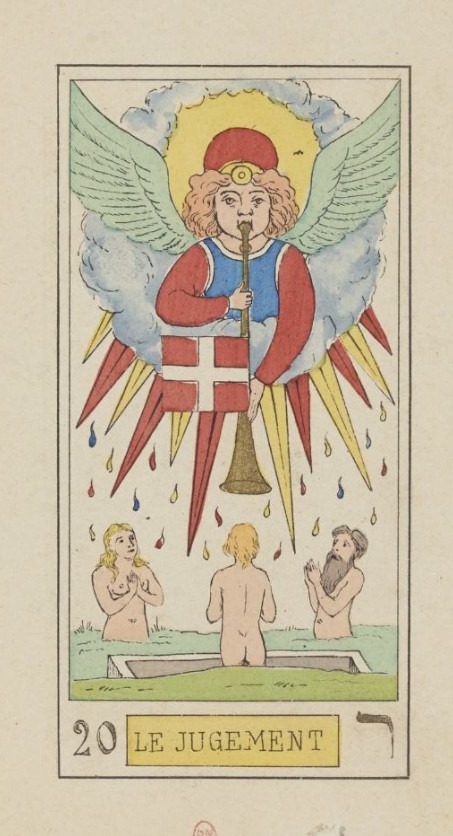
From an occult perspective, the judgement card represents spiritual transformation.
The rising figures symbolise transcendence.
Those who have passed the test and escaped from the shackles of the human body are now in communication with the divine.
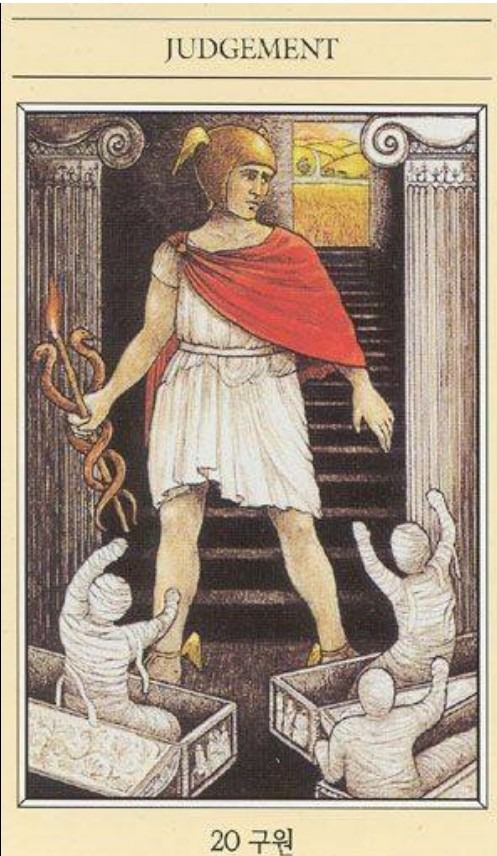
From a psychological viewpoint, tarot can be seen as a form of therapy, done alone or within a group, to address mental health, addiction or other negative thought cycles that interfere with day-to-day life.
Judgement shows the learning has been completed.
Individuals looking to make more sense of their lives can now see how they’ve been responsible for what has happened to them, either in terms of what they have done or, when situations seem uncontrollable, they’ve managed positive responses rather than negative ones.
They now have the tools they need to return to their lives in ways which wouldn’t have been possible without therapy or personal exploration of therapeutic practices.

The fool takes time to examine the symbols.
The angel reminds him of the lover’s and temperance.
The trumpet shows either seven blasts or seven different tones, like a heptatonic scale.
There’s a flag with a red cross, reminiscent of the insignia of the Knights Templar.
The cross has been linked to the four elements in the major arcana cards or, more specifically to judgement, it might represent a crossroads where judgement will involve deciding which path to follow.
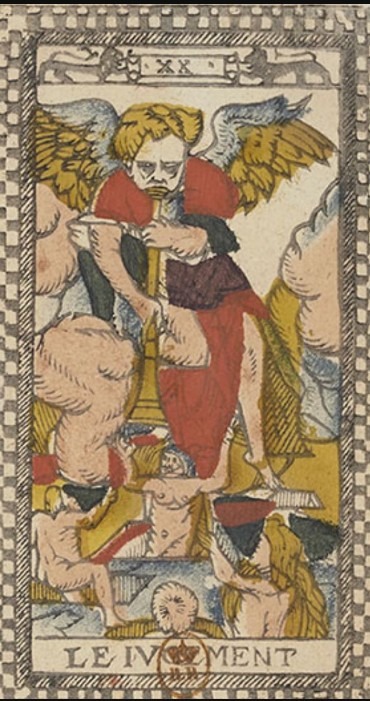
Six people (men, women and children) rise from their coffins, arms outstretched.
The coffins appear to be floating on water, while in the distance is a range of snow-capped mountain peaks.
E. Waite in his pictorial key to the tarot says the biblical interpretation of judgement is only for those who can see no further.
Looking below the surface will reveal other meanings.
Waite was a member of the Hermetic Order of the Golden Dawn, a secret society with temples rather than churches and a pantheon of gods and goddesses rather than a holy trinity. Later in his life, Waite turned to christian mysticism, an interest reflected in his tarot designs.
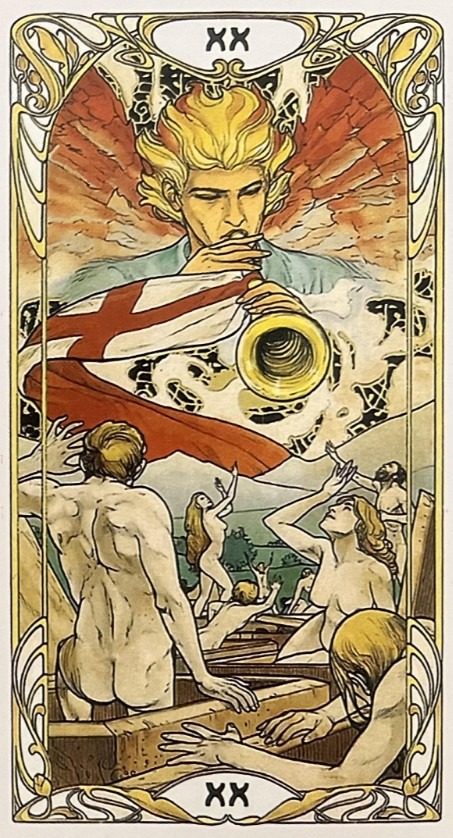
Judgement represents individual transformation, a process similar to the fool’s tarot experience.
Uncovering his roots requires an depth exploration of the self. The fool has taken this journey and reached a point where he’s achieved a higher level of understanding.
Judgement is the call to decide how best to move forward when the journey ends.
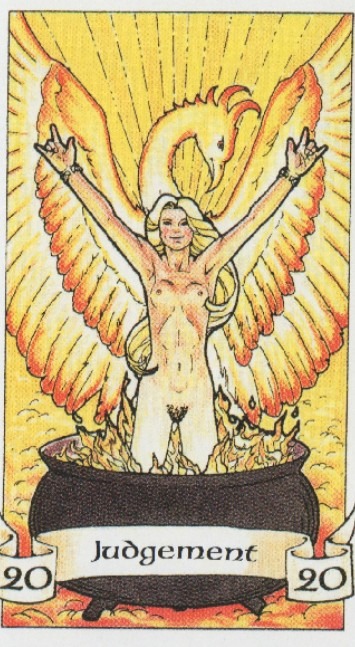
The fool is being called to make a fresh start.
It’s time for evaluation and assessment.
Assimilate the lessons.
Decide the directions his life will go from now on.
He has changed. Supressed emotion has come to the surface. His demons have stepped into the light and are now less scary, their power to dictate his responses have diminished.
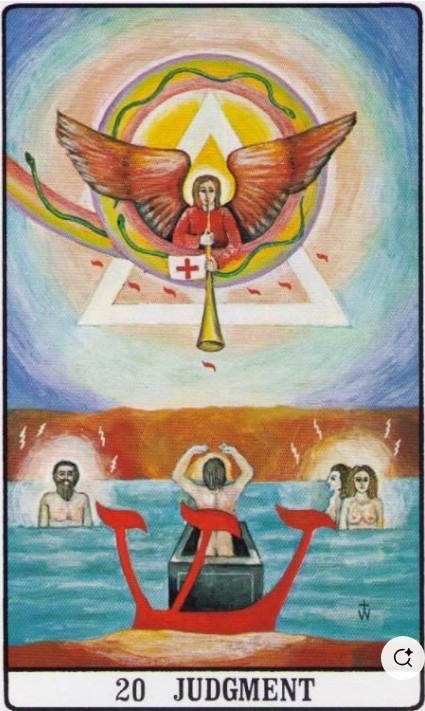
Think of judgement as coming out of rehab. Sobriety has been experienced but the individual has to leave the protection of the group and return to his previous life.
The fool has journeyed through the cards. He’s felt the integration of the star, faced his demons with the moon, and the layers of his psyche have come back together beneath the sun.
His consciousness is no longer limited and controlled by the unconscious, and he’s become aware of all the ego tried to keep hidden.
Was it worth it?
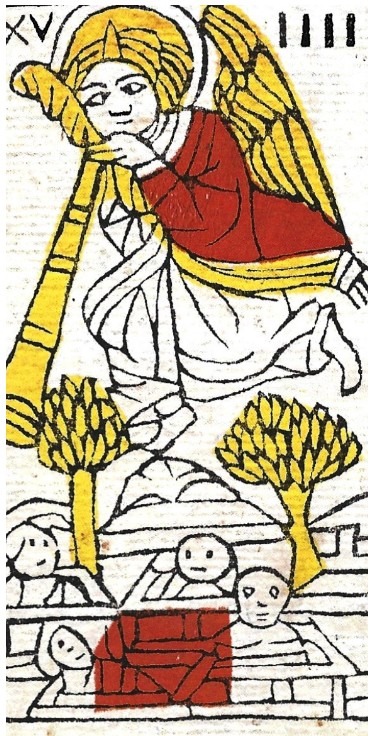
To delve into the immaterial, non-physical world of abstract thought has required the development of intuition and an exploration of the roots of emotional response.
The penultimate card invites him to consider and reflect. When he returns, it will be as a different person. Has he done enough? How will he fit back into his previous life? What has changed?
The fool realises time is one infinite moment.
The past, present and future are all the same.

Consciousness is timeless.
Regardless of what happens, the fool is solely responsible for making the most appropriate choice to all the events is his future life. While he’s gained in terms of knowledge and experience, the core of his existence remains constant.
The cards have changed his perspective. There’s no escape from the self. From now on, physical life-events and people will be seen with new levels of inner awareness.
He’s gained knowledge about the sources of his conscious beliefs and is learning to let go of negative thought patterns. He knows the part of himself referred to as I will always be present.
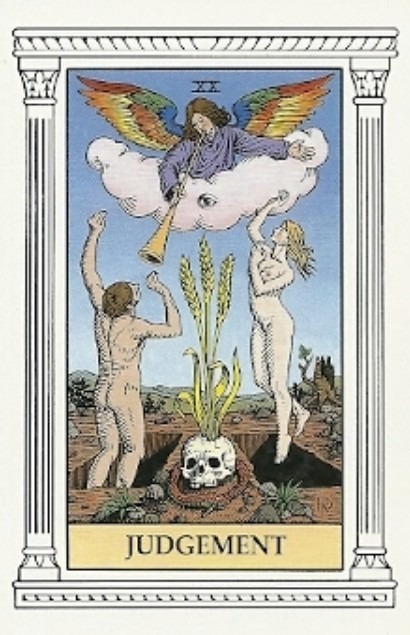
He has become the still point in a turning world.
The fool has learned to accept and love who he is in any given moment, and see every day as a new opportunity to make consciously informed decisions and judgements.
After the experience of wholeness and integration, he’s being called to carry this new knowledge and practice with him as he returns.
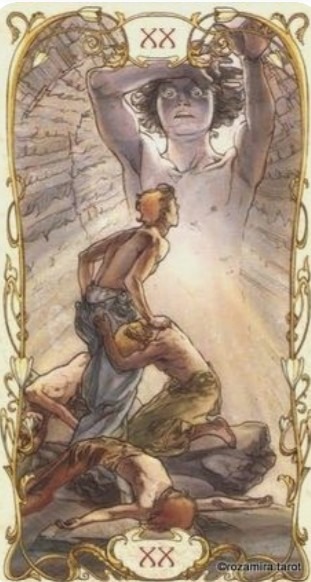
Whatever path he follows, from as you sow, so shall you reap to more eastern philosophies of karma, what the fool makes of himself is his own responsibility.
The veils have been removed, permanently. He can better judge right and wrong, and while he might slip slide into bad habits, he knows how to halt any potential negative progression.
The fool has become balanced; physically, mentally, and spiritually.
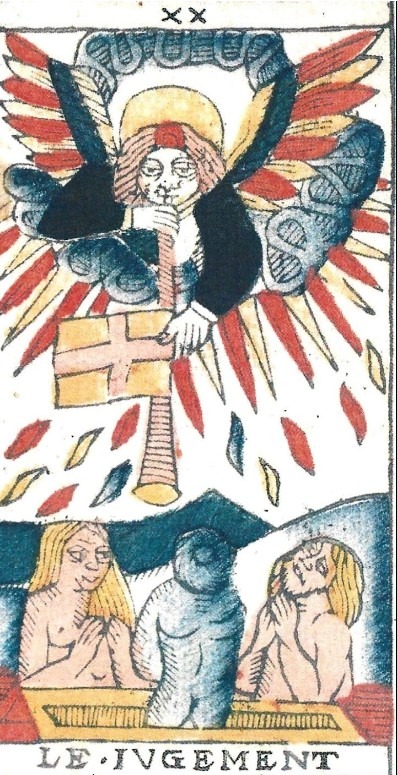
Whether it be acknowledgement of a god, a higher power, or his own ability to understand himself, life’s energy has touched him. He has a sense of being renewed, regenerated, reborn.
The final card is the world.
After judgement, the fool will return to where he came from when the journey began.
How will he manage this transition?
Join us for his final step on a walk through the tarot.

images my own, or copyright free from wikipedia commons and https://pixabay.com/